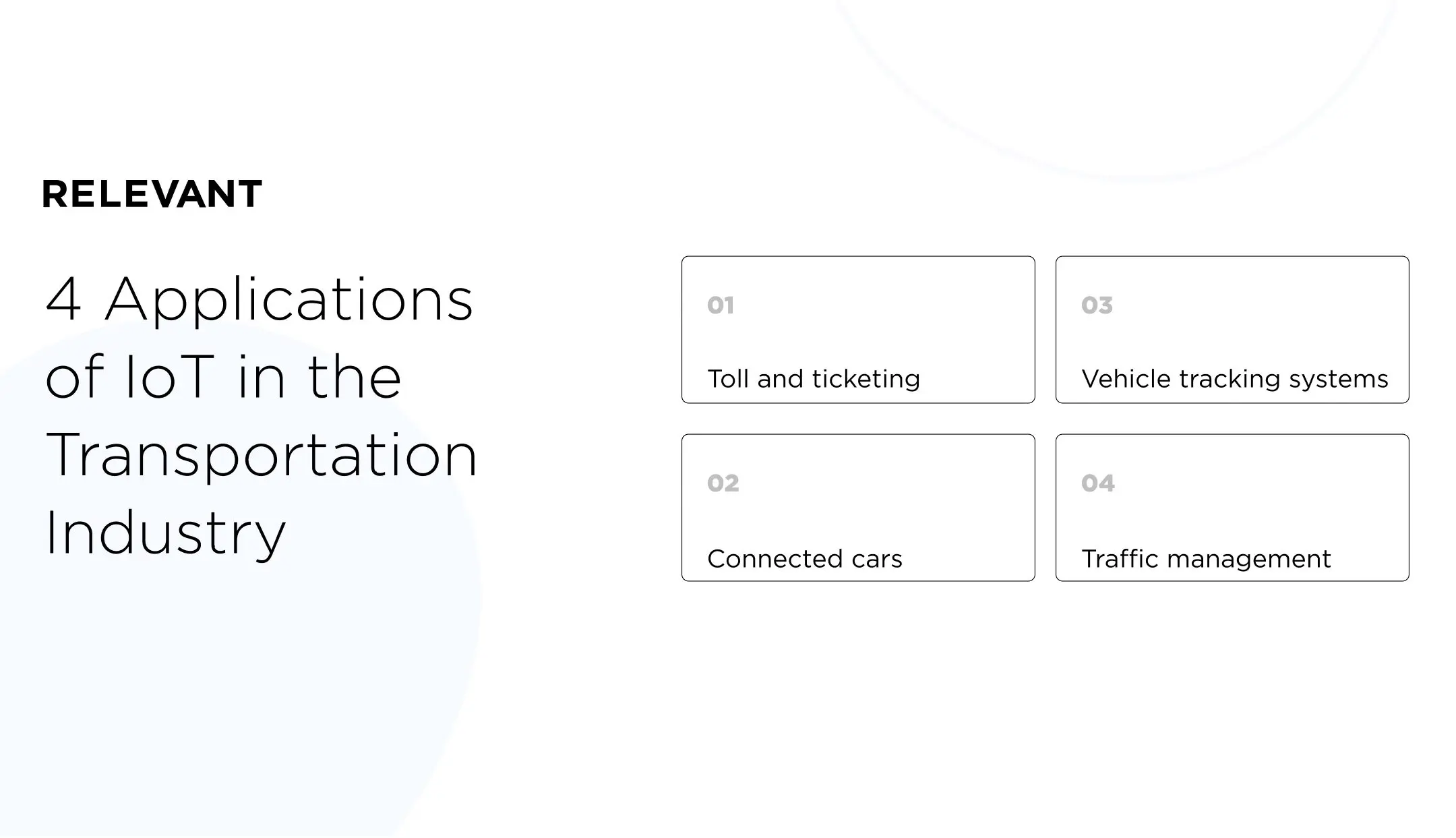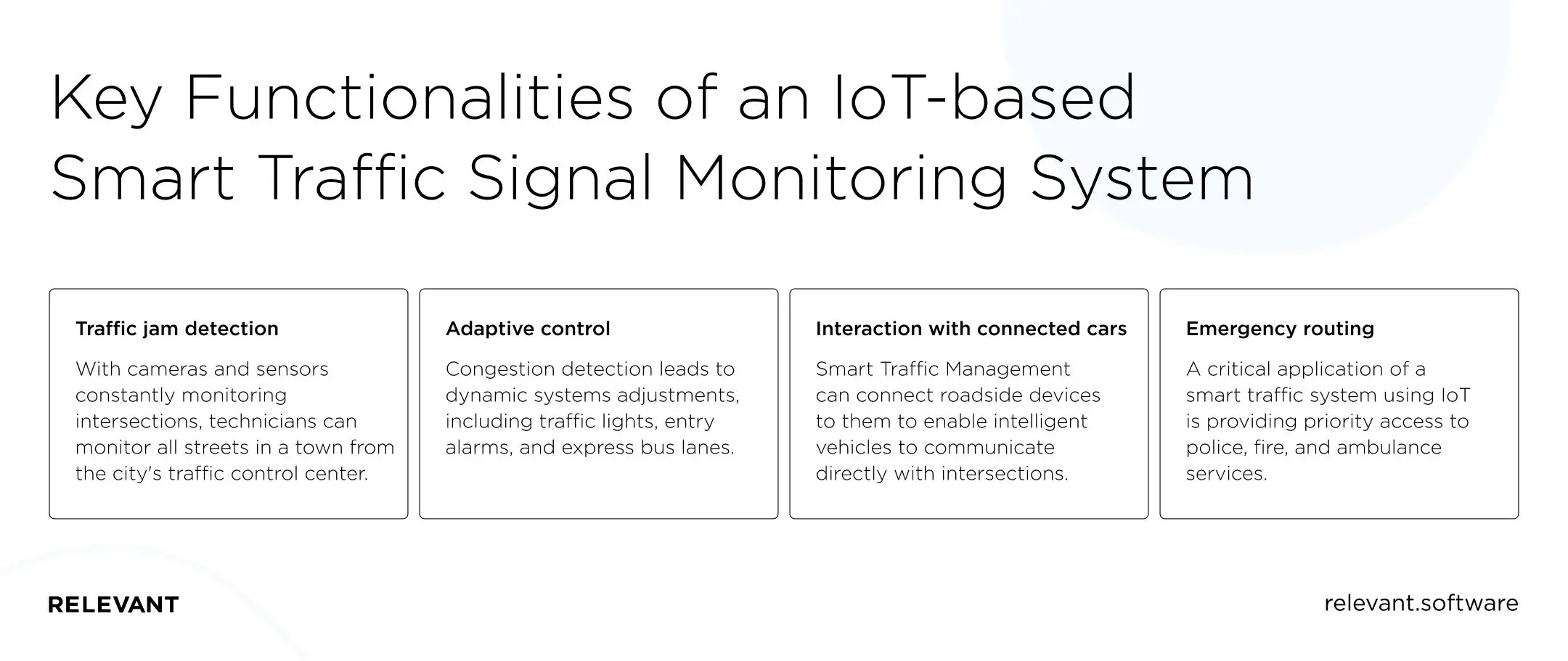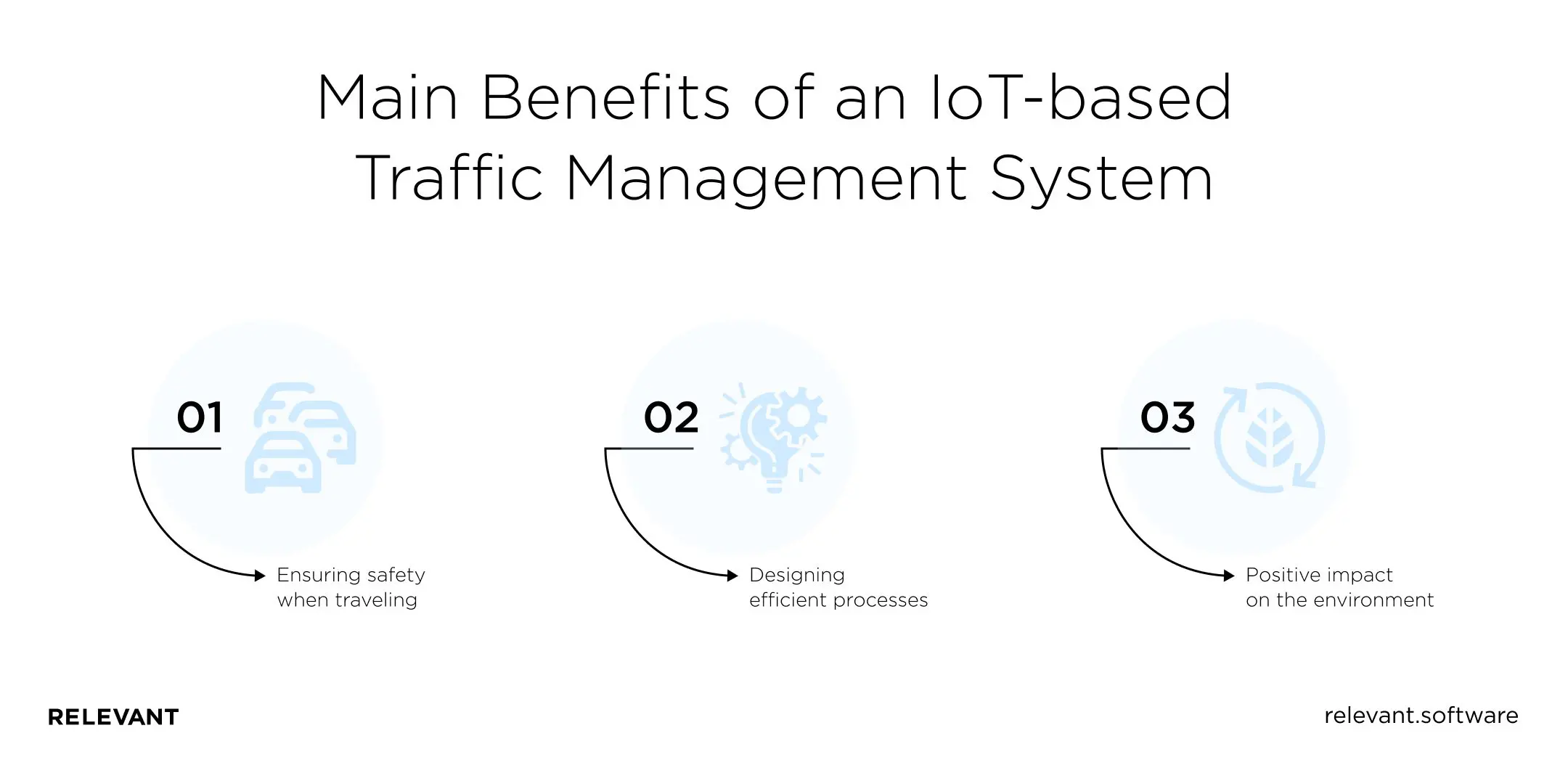IoT in Transportation: All You Need to Know About Smart Traffic Control System Using IoT

Rapid urbanization is a challenge for organizations that manage the city’s infrastructure and are responsible for comfort and safety. The number of cars is growing, traffic is becoming more intense, so congestion and traffic accidents are common.
Meanwhile, traditional traffic control systems have insufficient coverage to control all city traffic and cannot scale properly. Therefore, cities critically need modern intelligent solutions that handle traffic better and improve the comfort of drivers, pedestrians, and passengers.
Realizing the importance of IoT in transportation, we at Relevant are ready to help you conceptualize and implement your smart solutions. But first, let’s look at what the market looks like today.
How IoT is transforming the transportation industry
Over the past decade, the Internet of Things has made a quantum leap forward and has become the basis for intelligent digital solutions, which are so lacking in logistics and transport.
According to a report by Grand View Research, the global IoT device management market will grow to $5.1 billion by 2025 at a compound annual growth rate of 28.3%. Digitalization and the urgent need for communication and network technologies, including the transport industry, have become the market’s driving forces.

These innovative solutions prepare the city’s infrastructure for the next technology milestone, including connected vehicles and full 5G deployment. Juniper Research analysts estimate that by 2023 more than 62 million vehicles will be in communication with each other.
Considering that there were just over 1.1 million in 2019, you can estimate the average annual growth rate, and in four years, it will be 173%. Low latency vehicle-to-vehicle communication can minimize traffic problems and significantly improve road safety.
The applications of IoT in the transportation industry
MarketsandMarkets estimates that the global intelligent transport systems market will reach $30.7 billion by 2023. Companies will use IoT devices in many areas of the transport sector, especially in traffic congestion tracking systems, vehicle telematics systems, security and surveillance systems, which is just part of their potential.

There are other areas of the transport sector where the Internet of Things can transform the transport system:
Toll and ticketing
With the increase in the number of cars, queues at toll booths on highways have become commonplace. And while automatic tolls using RFID tags have reduced waiting times, further improvements are only possible using IoT technology.
Now we can connect a modern car to the Internet of Things, which will make it possible to detect it at a distance of up to a kilometer from the point of payment, automatically remove the charge and raise the barrier. Alternatively, payments can be debited from a digital wallet connected to the phone.
Connected cars
As mentioned above, all modern cars support an Internet of Things connection. Tracking systems using IoT is already being used in the freight and passenger transportation segment so that managers can efficiently manage their fleet. Monitoring systems also help monitor driver behavior and collect data on downtime and driving style. Examples of IoT-based applications include:
- Distance traveled and fuel consumption
- Travel planning
- IoT fleet management
- Driving schedule and driver rest breaks
- Alerts for overspeeding, cornering, accelerating, or braking
- Vehicle load monitoring
Vehicle tracking systems
IoT sensors such as RFID (Radio Frequency Identification) or AIDC (Automatic Identification and Data Collection) are excellent methods for tracking and adequately managing vehicles. RFID uses radio waves to determine position based on embedded microchips. These tags can convey information about what kind of car it is, where it is going, and at what speed. The advantages of a smart traffic management system using the internet of things are:
- Track Lost Vehicles with RFID
- Real-time vehicle traffic monitoring
- Efficient signal transmission by vehicles
Public transport management
The public transport segment uses innovative transport technologies such as passenger information systems, integrated ticketing, automated toll collection, passenger information display systems, and advanced transport logistics solutions. They all use IoT technologies that offer the following benefits:
- Real-time vehicle tracking for arrival time alerts via mobile devices and information displays for passengers at stops and stations.
- Personalized transport timetable tracking with information on fundamental changes such as delays, station closings, or re-routing.
- Real-time data tracking helps build the correct route due to unforeseen incidents such as accidents, road works, emergencies, etc.
Traffic management
When it comes to implementing IoT technologies in transport, the first goal is traffic jam problem-solving. The American Transportation Research Institute estimates that congestion costs the U.S. freight sector $74.1 billion annually. Traffic management Internet of Things solutions allows you to increase the capacity of city streets without actually adding new roads and play a vital role in the transition to smart cities.
They optimize traffic flow and keep traffic safe using sensors, cameras, routers, and cellular technologies to dynamically adjust controls such as traffic lights, highway exit counters, expressway bus lanes, highway bulletin boards, and even speed limits.
For example, Ford has introduced Traffic Jam Assist, a mode that allows the vehicle to match the car’s speed in front of a traffic jam. This speed matching makes it easier for drivers and smoothes traffic flows, and reduces congestion patterns.
In the future, these systems will be able to directly control vehicles when needed – for example, breaking them at intersections to prevent collisions with pedestrians or other vehicles.
Application for traffic jams using IoT technology include:
- Smart parking. IoT sensors in parking lots can transmit information about accessible parking spaces in real-time.
- IoT traffic light. Sensors installed in strategic locations can use IoT technology to collect data on congestion, moving vehicles away from these locations. IoT Big Data solutions can analyze this information, determine alternative routes, and improve traffic signaling to reduce congestion. Roadside lights can also work by the weather sensors installed on them. With a light control system, roadside lighting will change with the onset of day or night and when weather conditions require it.
- Smart ambulance. Video surveillance systems and road sensors can help locate incidents and report them to the nearest emergency room.

Intelligent traffic management with the help of IoT technology
IoT traffic management systems are automated systems that incorporate the latest advances in IoT technology. Each IoT platform has its own set of unique features and mechanisms. Specifically, for Smart traffic management system, it offers:
- Data warehouse and data access.
- Communication, coordination, and device control capabilities.
- Deploy cloud and software for connected devices.
- And all the necessary infrastructure for all of the above.
IoT in Smart traffic management system: How does it work?
Intelligent Transportation Systems can help solve the traffic problem by integrating IoT technology with existing infrastructure. Take, for example, an IoT-based smart traffic signal monitoring system.
It relies on a priori information provided by the IoT sensors and adjusts the traffic signals so that the time interval depends on the number of vehicles on that particular part of the road. The main advantage of this system is that it can reduce downtime and traffic density in various areas.
Some of the key functionalities that cities acquire through these systems include the following:
- Traffic jam detection. With cameras and sensors constantly monitoring intersections, technicians can monitor all streets in a town from the city’s traffic control center.
- Adaptive control. Congestion detection leads to dynamic systems adjustments, including traffic lights, entry alarms, and express bus lanes.
- Interaction with connected cars. Smart Traffic Management can connect roadside devices to them to enable intelligent vehicles to communicate directly with intersections.
- Emergency routing. A critical application of a smart traffic system using IoT is providing priority access to police, fire, and ambulance services.

The benefits of an IoT-based traffic monitoring/management system
The Internet of Things in the transport industry is the unification of objects into a single network using actuators, built-in sensors, and other devices that collect and transmit data to a single central console.
One of the advantages of IoT technology is that sensors and beacons can be installed in cars and trains and integrated into street lamps, bus stops, and railway platforms. That will ensure consistent visibility and reduce accidents. In addition, transport organizations will be able to analyze the data passing through IoT devices and improve the quality and efficiency of their services. As a result of the traffic management IoT, the industry will benefit from:
Safe travel
The ability to track metrics such as train speed, carriageway temperature, or the number of vehicles at an intersection using IoT technology can help improve the safety of transportation systems around the world.
Efficient processes
Municipalities and organizations adopting IoT technologies are reaping significant productivity benefits. They can better monitor critical infrastructures and design efficient processes to minimize operating costs and increase system throughput.
Improving the environment
IoT-enabled systems can quickly respond to changing traffic patterns and return real-time data to help drivers plan their journeys better with better congestion monitoring. Reducing congestion and energy consumption has a positive impact on the environment.

The challenges of integrating IoT in the traffic management system
While IoT traffic management has advanced capabilities for road infrastructure, we can not ignore some impediments. Let’s consider the most important ones:
Additional security requirements
As the number of IoT devices connecting to the central network grows, its vulnerability increases the likelihood of hacker attacks to take over confidential data. Therefore, any traffic management solution must have a basic and an additional level of security. Typically that data transmission encryption, user access control, and device authentication.
The need for high-tech network infrastructure
All high-tech solutions require high-speed data transfer methods. Since IoT solutions involve working with large amounts of data and many IP addresses, network facilities must maintain constant communication and collect data from sensors and other IoT devices. Thus, to operate efficiently, you need strong networks that can meet the needs of the Internet of Things as they evolve.
Time spent on adaptation
The IoT-based intelligent traffic management system includes thousands of sensors and devices, and it is impossible to manage all of these endpoints manually. A digital traffic solutions provider must provide an intuitive IoT traffic control system with an automatic connection and a centralized control panel.
Additional investment
As mentioned above, the implementation of IoT technology in the long term reduces costs and optimizes the operations of any organization. But the initial integration requires investment.
These are the costs associated with the network infrastructure, the modernization of vehicles directly connected to the IoT solution, and the planning, implementation, management, and security of IoT systems. Therefore, many customers immediately submit IoT development on outsourcing to Ukraine, known for its pool of talented programmers and quality solutions at a fair price.
How can Relevant help you with your IoT project?
Technological progress has made its way to the transport industry. But to seize its opportunities, key players in the transportation sector need an experienced technology partner who is familiar with the specifics of this niche industry.
At Relevant Software, we develop efficient traffic management systems based on IoT with automatic tracking, monitoring, and data processing functions. Whether it’s – an operational efficiency solution or an end-user product, it will be scalable but cost-effective and can support the changing demands of the entire system, network, and process.
IoT-based intelligent traffic management system from Relevant Software will provide dynamic traffic signal processing based on traffic density. To keep track of traffic updates and timely alerts, we are implementing an interactive IoT dashboard that visualizes the traffic situation in near real-time on an accurate road network map.
Data on traffic, congestion, incidents, weather conditions is collected, processed, and retrieved from the positioning platform for display on a single console of the driver’s or organization’s application.
In addition, we can develop systems for using and tracking the functionality of a scooter fleet, smart traffic light systems for recognizing approaching vehicles, light control systems, IoT mobile apps, IoT Big Data solutions, and many other innovative solutions that are an essential part of smart cities.
Conclusion
The future of the transport industry looks pretty optimistic with digital traffic solutions. Therefore, we advise you to take advantage of the already apparent technological and organizational breakthroughs.
Relevant Software specializes in solving business problems using software solutions, including IoT for transportation projects. So if you want to hire IoT developers to create a custom-made IoT app or improve an existing one, contact us right now. In addition to experience and technology, we will provide comprehensive information on emerging trends to keep your IoT solution relevant in the long term.



